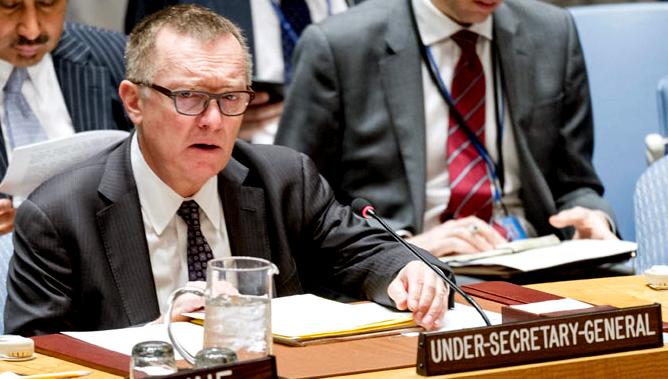
Jeffrey Feltman, Under-Secretary-General for Political Affairs, briefs the Security Council meeting on Threats to international peace and security caused by terrorist acts Fourth report of the Secretary-General on the threat posed by ISIL (Da’esh) to international peace and security and the range of United Nations efforts in support of Member States in countering the threat
As ISIL is militarily on the defensive in several regions, the terrorist organization that is also known as Da’esh continues to encourage its sympathizers outside conflict zones to perpetrate attacks. And despite shrinking revenue streams, the group still has sufficient funds to carry on fighting. These are among the key points from the Secretary-General’s 4th report on The threat posed by ISIL/Da’esh to international peace and security and the range of United Nations efforts in support of Member States in countering the threat.
Published on 2 February 2017, the report (S/2017/97) was submitted as a follow-up to Security Council resolution 2253 (2015), which requests the Secretary-General to submit updates every four months on the threat that ISIL represents to the international community and the principles and values of the Charter of the United Nations.
“ISIL is adapting in several ways to military pressure – resorting to increasingly covert communication and recruitment methods, including by using the ‘dark web,’ encryption and messengers,”
– noted Under-Secretary-General for Political Affairs Jeffrey Feltman during his briefing to the Security Council on 7 February 2017.
Focusing on Europe, North Africa, and West Africa, the report notes that Europe has experienced range of terrorist attacks since 2014, with some of these attacks directed and facilitated by ISIL or through its assistance and propaganda. While the military offensive in Libya has dislodged ISIL from its stronghold Sirte, the group’s threat to Libya and neighbouring countries persists. The terrorist organizations’ fighters – estimated to range from several hundred to 3,000 – have moved to other parts of the country. ISIL’s presence in West Africa and the Maghreb has grown, though it does not control significant amounts of territory in the region. Finally, ISIL-affiliate Boko Haram is attempting to spread its influence and commit terrorist acts beyond Nigeria, thus remaining a serious threat – despite being plagued by financial difficulties and an internal power struggle, which has led to its split into two factions.
The report highlights the importance of international cooperation and information sharing, referring to Security Council resolution 2322 (2016), which calls upon Member States to establish laws and mechanisms to allow for the broadest possible international cooperation in the judicial and law enforcement spheres. S/2017/97 stresses that information sharing and cooperation on addressing terrorist attacks have improved, leading to a curtailing of the travel of foreign terrorist fighters between States in Europe. Maghreb and West Africa also show improvements in this area.
The report was prepared with the input of the Counter-Terrorism Committee Executive Directorate (CTED), in close collaboration with the Monitoring Team of the 1267/1989/2253 ISIL (Da’esh) and Al-Qaida Sanctions Committee, as well as other relevant United Nations actors and international organizations.

